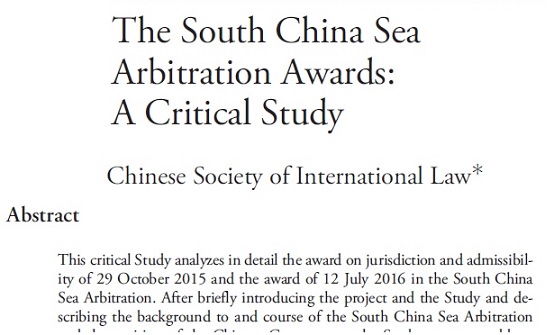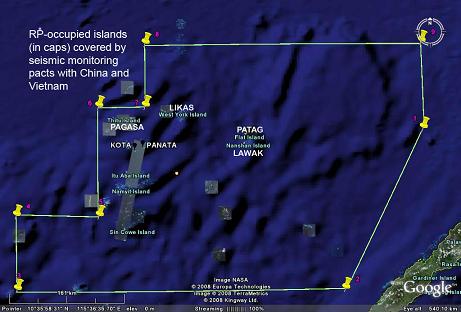Months before the second anniversary of the Arbitral Tribunal’s decision on the case filed by the Philippines to nullify China’s nine-dash line map and other issues in the South China Sea, China commissioned a study which was completed in December 2017.
Published by Oxford University Press, “The South China Sea Arbitration Awards: A Critical Study” is an intimidating 548 page assertion by China of its ownership of the waters, reefs, shoals, rocks in the Spratlys as part of its claim over almost the whole of South China Sea.

There is nothing new that we have not read or heard before. But it’s good to see almost all in one thick file.
The study underscores the folly of President Duterte’s tolerant attitude of the presence and control of China in disputed areas especially Scarborough Shoal off Zambales in Luzon.
The study shows China will use every concession to bolster its claim or position.
Take this case of the 2004 Joint Marine Seismic Undertaking or JMSU which was entered into by the government of Gloria Arroyo and China covering the areas off Palawan including the much coveted Reed Bank which Duterte is now trying to revive through a joint exploration agreement.
The JMSU was mentioned to stress that there were talks and cooperation in many levels and it was unnecessary for the Philippines to go to the Arbitral Tribunal.
“…as early as in March 1999, the two sides held the first China-Philippines Experts Group Meeting on Confidence-Building Measures. Subsequently, the Experts Group on Confidence-Building Measures met a number of times. On 3 September 2004, the two sides issued the Joint Press Statement between the Government of the People’s Republic of China and the Government of the Republic of the Philippines, stating that, ‘The two sides reaffirmed their commitment to the peace and stability in the South China Sea and their readiness to continue discussions to study cooperative activities like joint development pending the comprehensive and final settlement of territorial disputes and overlapping maritime claims in the area.’
“Two days before the issuance of the Joint Press Statement, upon approval by both governments and in the presence of the leaders of the two countries, China National Offshore Oil Corporation (CNOOC) and Philippine National Oil Company (PNOC) signed an Agreement for Joint Marine Seismic Undertaking in Certain Areas in the South China Sea, deciding to undertake joint marine seismic exploration in the relevant maritime areas. The ‘agreement area’ as defined therein is within the areas of overlapping maritime claims of the two States and also within the areas involved in the Philippines’ submissions.
“Just as stated in China’s Position Paper issued on 7 December 2014: China and the Philippines are maritime neighbours and ‘States with opposite or adjacent coasts” in the sense of Articles 74 and 83 of the Convention. There exists an issue of maritime delimitation between the two States. Given that disputes between China and the Philippines relating to territorial sovereignty over relevant maritime features remain unresolved, the two States have yet to start negotiations on maritime delimitation. They have, however, commenced cooperation to pave the way for an eventual delimitation.”
The study said that “At the heart of the relevant dispute between China and the Philippines in the South China Sea lies the territorial issue over certain component features. This issue has a significant impact on their claims to maritime rights and interests in the South China Sea. “
On the JMSU, the study said, “…it shows that the Philippines did acknowledge the existence of a maritime delimitation dispute with China.”

This is exactly what the Philippine panel anticipated that China would use to bolster their claim in the South China Sea that’s why the Supreme Court didn’t release its decision on the case filed by Bayan Muna partylist in 2008 questioning the JMSU’s legality based on the Constitutional provision that exploration of Philippine natural resources can only be done by the State.
Bayan Muna suit asserted that the alternative term “seismic survey” used by then House Speaker Jose de Venecia and Arroyo’s energy and foreign affairs officials is actually “exploration” which foreigners are prohibited to undertake under the Constitution. JMSU was a tripartite agreement with China, the Philippines and Vietnam.
Unconfirmed sources said the decision ready during the Aquino administration favored Bayan Muna’s suit but it was deemed unwise to release it as China would use it to say that the Philippine had recognized its claim which is what it exactly stated in this study.
The JMSU was tied to the $904.38 million package of investment from China that included the graft-ridden Northrail, NBN-ZTE telecommunications deal and Zhongxing Technology Equipment (ZTE) Diwalwal mining project.
JMSU was completed in 2007. The results of the seismic survey have not been made public but one thing is sure: China knows what’s deep down in the Philippines’ Economic Exclusive Zone.
The abstract of the study says it analyzes in detail the award on jurisdiction and admissibility of 29 October 2015 and the award of 12 July 2016 in the South China Sea Arbitration.
The study tackles jurisdiction; admissibility; historic rights; the status of China’s Nansha Qundao (Spratlys) and Zhongsha Qundao (Macclesfield Bank); the legality of China’s activities in the South China Sea; due process and evidence.
The Study concludes that the Tribunal’s many errors deprive its awards of validity and threaten to undermine the international rule of law.
Pandakikay has done a lot of damage to the Philippine’s territorial integrity and sovereignty. Now that she’s back in power, she’ll do further harm than ever before. She and Duterte will work in tandem to advance China’s interests beyond the Chinks’ expectations.
not all that glitters is gold and similarly, the 548 pages of chinese assertions making up china’s critical study on south china sea arbitration award is by the chinese, for the chinese and of the chinese, with tacit nod from digong and ate glue, sticky glue, lol! didikit, nandidikit at madikit, I’m expecting jose pidal uli, pedal yata for feet, quick to gapang the feet and quick to mount the platform.
I was looking out for her shoes tuloy, baka red yon matching her red dress. the color red to impress the chinese ambassador, as red as the chinese flag, and as red as the banner that says, welcome to pinas, province of china, lol!